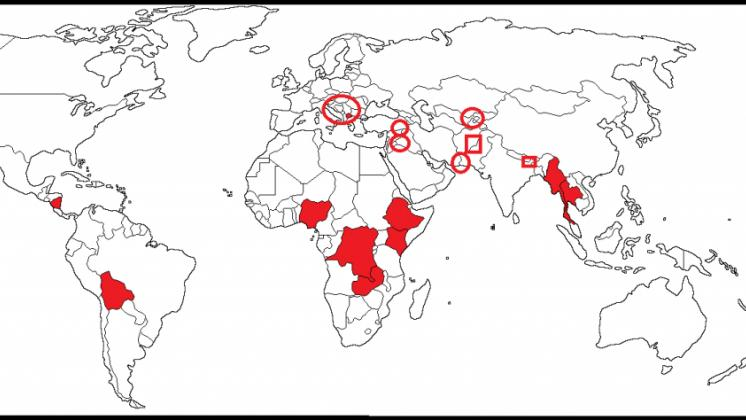
The world is presently in the midst of an epochal transition from unipolarity to multipolarity that is expected to characterize the foreseeable decades of the 21st century, if not its entirety. There are multiple dimensions to this paradigm-shifting process, which can leave observers completely overwhelmed when trying to make sense of it all, and most analysts tend to focus just on one or a couple factors while leaving out the rest of the bigger picture. This isn’t through any deliberate fault of their own, but rather due to their expert specialization in certain fields and the attendant time commitments that this typically entails, both of which largely hold them back from researching other related trends and grasping a comprehensive sense of everything else that’s happening.
Background Reading
What’s needed at this crucial moment in time is a holistic review of International Affairs as they currently stand and a corresponding model for forecasting their evolution throughout the manifold changes that are concurrently taking place across the world. The author published multiple works that are relevant to the present research and from which most of the forthcoming analysis will be based, so they’ll all be enumerated below in order to provide the reader with the in-depth reference materials that will aid in understanding everything else that follows:
- Hybrid Wars: The Indirect Adaptive Approach To Regime Change (kindle version available here)
- The Law Of Hybrid War: Eastern Hemisphere (individual chapters available for free at www.orientalreview.org)
- 21st-Century Geopolitics Of Latin America (individual chapters available for free at www.geopolitica.ru)
- The Meaning Of Multipolarity (individual chapters available for free at www.geopolitica.ru)
- The Afro-Eurasian Blueprint For A Multipolar World Order
- Greater Eurasia Scenarios (individual chapters available for free at www.geopolitica.ru)
- Lead From Behind: How Unipolarity Is Adapting To Multipolarity
- What’s CPEC, And How Does The Future Of Multipolarity Depend On It?
- Competitive Connectivity Is At The Core Of The New Cold War
- The Chinese-Indian New Cold War
Regional/Silk Road Globalization
To put it succinctly, the unipolar world is characterized by the US’ predominant hegemony in a wide variety of spheres, whether exercised directly through unilateral initiatives or indirectly (“Lead From Behind”) through its regional and institutional partners. The multipolar forces in the world are working to replace the US-led international order with a diversified array of multiple stakeholders in order to bring balance to International Affairs. Importantly, they seek to do this through progressively reforming international institutions such as the UN, IMF, World Bank, and others, as well as creating their own counterparts to some of them like the BRICS New Development Bank or outright forming entirely new and unprecedented organizations like the SCO.
One of the latest proposals has been to broaden the BRICS format through what has now been called the “BRICS-Plus” strategy, which essentially seeks to have each of the five member states encourage multilateral cooperation between each other’s respective regional integration organizations. As Russian Valdai Club expert Yaroslav Lissovolik describes it, this could see Mercosur, the SADC, the Eurasian Economic Union, SCO, SAARC, and ASEAN all cooperating with one another in changing the world order. In the spirit of President Xi’s speech at the World Economic Forum in Davos in January 2017 and the steps outlined in the September 2017 Xiamen BRICS Declaration, this essentially amounts to what observers can describe as “Regional Globalization”, or “Silk Road Globalization”.
Missile Defense Shield, Prompt Global Strike, And The Naval Race
It’s not enough, however, just to reform and replace certain institutions, since the underlying basis of American control over the world is through economic means as enforced by military ones. In certain cases, though, the US is unable to directly attack its rivals such as Russia and China without suffering unacceptable damage through a nuclear second strike, ergo why Washington is pushing to build anti-missile installations all around Eurasia in order to ring in these Great Powers and diminish their most credible deterrent capability. Complementary with this are the US’ space weapons, whether based in this theater (X37-B and the policy of “Prompt Global Strike”) or directed towards it (anti-satellite weapons, whether kinetic such as missiles or non-kinetic like lasers).
Neither the US’ missile shields nor its space-related weaponry are sufficient enough for ensuring that the country is defended from submarine-launched ballistic missiles, which form a crucial component of any country’s nuclear triad. This explains why there’s an ongoing naval race across the world as the US seeks to ensure its dominance in the high seas in the face of rising competition from Russia, China, and others. The global ocean is also important for another reason as well, and this one relates back to the economic basis of American dominance over the world. China depends on the international waterways for the vast majority of its trade, which makes it inordinately vulnerable to any US efforts to block certain chokepoints such as the Strait of Malacca and Suez Canal.
OBOR’s Global Reorganization
Understanding the sudden systemic-shaking consequences that any hostile action like this could inflict for China’s domestic socio-economic stability, the People’s Republic prudently foresaw the need to pioneer ambitious trans-continental trade routes to its crucial European partner, as well as secure the Sea Lines Of Communication (SLOC) along its existing maritime ones in order to safeguard its access to the growing economics of Africa. The latter are exceptionally important nowadays because their growth is expected to allow Beijing to relieve itself of its industrial overproduction so long as it can succeed in building up these marketplaces and stabilizing them. As for the Western Hemisphere, China wants to increase its soft presence here as a means of competing with the US and asymmetrically countering America’s moves in the South China Sea.
Altogether, the above stratagem explains the essence of China’s One Belt One Road (OBOR) global vision of New Silk Road connectivity, which is designed to transform the world’s trading networks so as to facilitate the transition from a unipolar American-led international order to a diversified multipolar one safeguarded by a host of Great Powers. It also, however, provides the blueprint for how the US will oppose the greatest threat thus far to its worldwide hegemony, as all that Washington has to do is encourage identity-centric Hybrid Wars in the geostrategic transit states along these corridors in order to disrupt, control, or influence them in ways which remove their multipolar game-changing impact.
Hybrid War Hijinks
To this end, the US utilizes information warfare and NGOs to exacerbate already-existing fault lines within the targeted country, or sometimes completely engineer new ones, after which it employs its regional partners to funnel weapons and material support to the incipient anti-government movement out of the shared interest that they have in seeing the said initiative succeed. Whether it’s regime tweaking (political concessions), regime change (leadership change), or a regime reboot (total political-constitutional reform), the US desires an outcome which will provide it with the ability to interfere with the New Silk Roads that China is building all across the world.
This might be brought about by a Color Revolution, an Unconventional War, or a phased transition between either of them, both of which might ultimately end in direct multilateral military intervention along the lines of the 2011 War on Libya. Every country is vulnerable in principle to these tactics, but the Eastern Hemisphere – especially the non-Western countries of Afro-Eurasia – are more susceptible than the Western one owing to its more diversified demographics and relevant history that make its prospective socio-demographic battlegrounds more easily exploitable. In order to comprehend just how worldwide of a competition this is, one needs to become acquainted with all of the existing, planned, and prospective Chinese-built connectivity corridors across the world.
Connectivity Corridors
Here are three maps highlighting the various Silk Roads in Eurasia, Africa, and Latin America:
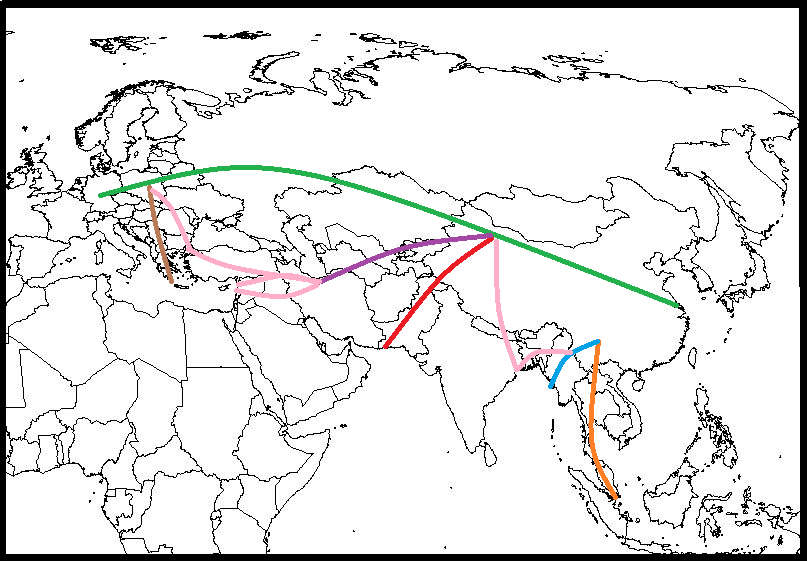
- Green: Eurasian Land Bridge
* Brown: Balkan Silk Road
- Purple: Trans-Central Asian Silk Road
- Red: CPEC
- Blue: China-Myanmar Economic/Energy Corridor (CMEC)
- Orange: ASEAN Silk Road
- Pink: prospective projects/interconnectors
- BCIM Economic Corridor
- China-Nepal-West Bengal
- Mideast-Europe
- Direct overland route via “Kurdistan”
- Maritime route to Latakia or Beirut via “Kurdistan” and/or Sunni-Shiite deserts
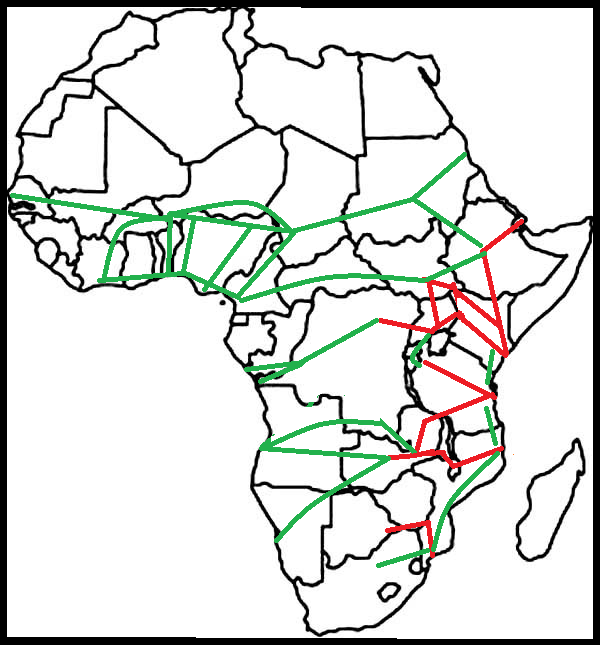
Red Lines are announced and/or built projects, while green ones are prospective. From North to South, the existing or planned Silk Roads are:
- Djibouti-Addis Ababa Silk Road (Ethiopian Silk Road)
- LAPSSET Economic Corridor
- Standard Gauge Railroad
- Central Corridor
- TAZARA
- Nacala Corridor
- Ponta Techobanine Railway
As for prospective projects, from North to South, these are:
- Saharan-Sahelian Silk Road
- CCS (Cameroon-Chad-Sudan) Corridor
- Nigerian Silk Roads
- Cross-Congo Intermodal Corridor
- Benguela Railway/Northwest Corridor to Angola
- Walvis Bay Corridor
- Tripartite Free Trade Area Corridor (South Africa to Sudan, following the African Renaissance Pipeline between Mozambique and South Africa with added interconnectors between existing projects up north)
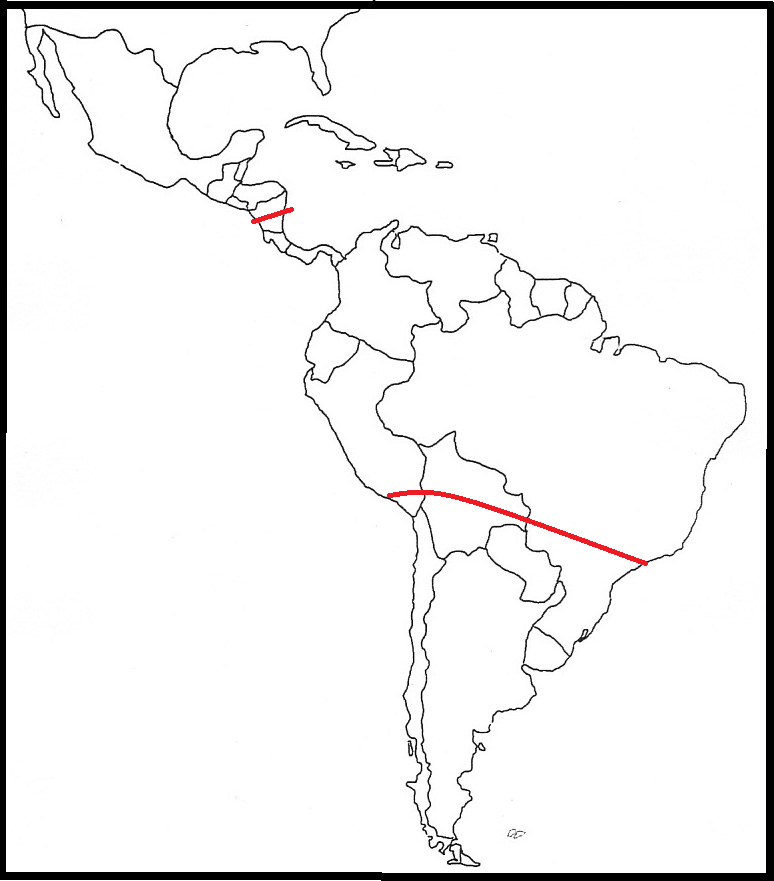
There are only two Silk Roads of importance in the Americas, and those are the Nicaraguan Canal and the Transoceanic Railroad (TORR) between Brazil-Bolivia-Peru.
Strangling The Silk Roads
The three maps provided above are very useful in pinpointing the most geostrategic transit states and sub-state identity communities along the New Silk Roads, which are accordingly expected to become future Hybrid War battlegrounds. Here’s what the world looks like with only those said entities highlighted:
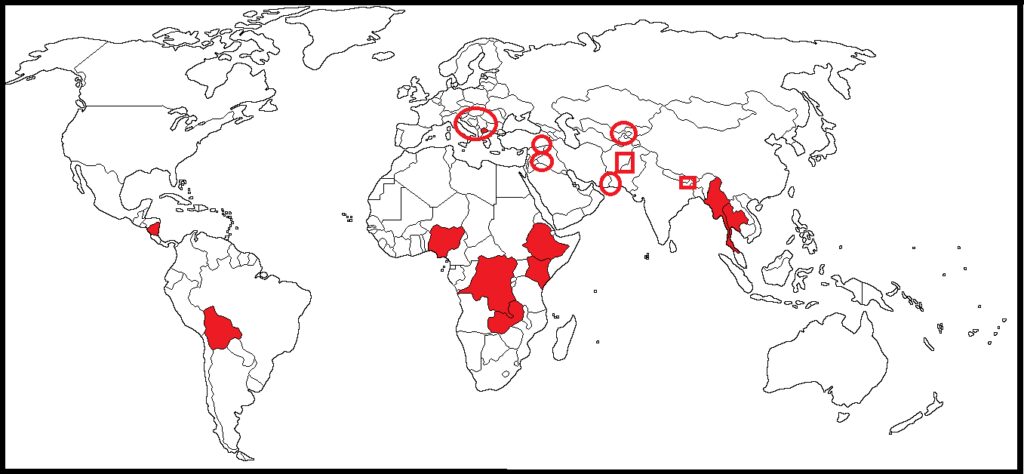
As can be seen, the states which are most vulnerable to externally provoked Hybrid Wars at the nationwide level are, from East to West:
- Thailand
- Myanmar
- Ethiopia
- Kenya
- Republic of Macedonia
- Democratic Republic of the Congo (DRC)
- Zambia
- Nigeria
- Bolivia
- Nicaragua
There are also some sub-state transnational issues that could be aggravated by outside forces in order to disrupt New Silk Road transit through several geostrategic states, and from East to West, they are:
- “Greater Nepal” (as manifested by Gorkhaland in India, but countered by India in Nepal through the Terai)
- Fergana Valley
- Cross-border Afghan-originating terrorism
- Balochistan
- “Kurdistan”
- Sunni-Shiite sectarianism across the “Syraq” desert
- Bosnia (directly involving Serbian and Croatian interests, but indirectly affecting the entire Balkans)
The prevailing trend is that the “Greater Heartland” of Eurasia – Mideast, Central Asia, and South Asia – is most directly threatened by latent transnational sub-state threats, while the rest of the transit states elsewhere across the world are more at risk of strictly internal threats such as those expostulated upon in the author’s previously cited texts at the beginning of this analysis. The easiest way for catalyzing these conflict scenarios is to exploit the “Clash of Civilizations”, which is in and of itself an American blueprint for dividing and ruling the Eastern Hemisphere.
Amidst the countless dangers to China’s Silk Road plans, one prominent feature stands out the most, and it’s that the Eurasian Land Bridge between China-Kazakhstan-Russia is the most secure of all of the corridors. As such, this makes it absolutely vital to the future of the Multipolar World Order and endows its two main transit states with unparalleled strategic significance. Although Russia and Kazakhstan are targeted in their own ways, their internal composition and geographic location largely insulates them from the “standard” Hybrid Wars that are expected to rage elsewhere across the world.
Democratic Security
The best way for the emerging Multipolar World Order to confront these myriad Hybrid War threats is through proactive measures in strengthening their individual and collective Democratic Security. This concept was introduced by the author and elaborated on in a few analytical proposals published across the past two years:
- Democratic Security In Macedonia: Between Brussels And Moscow
- Color Revolution Technology Isn’t Just Black And White
- NGOs And The Mechanics Of Hybrid War
- Color Revolutions And Culture: Patriotism Vs. Nationalism
- The “Deep State” And Political Transitions In “National Democracies”
The overall idea is that states need to implement a holistic approach to security which involves not just conventional military measures, but also economic, informational and even ideological ones (whether directly proclaimed or not). International cooperation through multipolar institutions such as BRICS, the SCO, and even to a larger extent most of the G20 would allow for tremendous progress to be made on these fronts. Intense care, however, must be taken to ensure that any institutional integration which takes place in the name of Democratic Security isn’t done at any other state’s perceived “zero-sum” expense, including some of the participating ones which might worry that they’re not being treated as equal partners in this process.
Overarching Trends
Taking stock of global processes and relying on the detailed information contained in all of the earlier-cited materials, it’s possible to identity a handful of overarching trends in each of the three Silk Road theaters (Eurasia, Africa, and Latin America) described in the previous section. Before doing so, the author suggests that the reader takes the time to review two of his earlier-published works:
- Greater Eurasia Scenarios (individual chapters available for free at www.geopolitica.ru)
- 2017 Forecast (individual chapters available for free at www.geopolitica.ru)
The referenced materials contain more in-depth details than what the present analysis accounts for, though the following will still draw attention to the most impactful trends ongoing across the world:
Eurasia:
- Indian Interference:
Original BRICS and newly inaugurated SCO member India has been groomed to become the unipolar world’s preferred “counterweight” to China, unable to physically challenge it one-on-one but capable in the future of creating enough trouble for the New Silk Roads and multipolar integration processes in general that Beijing is forced to respond to it in one way or another.
- Russia’s Eurasian Balancing Act:
The author requests that the reader check out his two pieces on how “Russia’s Diplomatic Balancing Act In Asia Is To The Benefit Of Its Chinese Ally” and “Russia’s Foreign Policy Progressives Have Trumped The Traditionalists”, but the main idea that they have in common is that Russia’s envisioned 21st-century geostrategic role is to become the supreme balancing force in the Eurasian supercontinent, and it’s clinching a variety of “non-traditional” partnerships across the hemisphere to that end.
- ASEAN’s Accelerated Integration:
The Association of Southeast Asian Nations will continue to deepen its member states’ multilateral cooperation into the ASEAN Economic Community (AEC) and the incipient trilateral military/anti-terrorist coordination between the Philippines, Malaysia, and Indonesia, with the only real systemic threats to its cohesion coming from what might once again be the (civil war-torn) “pariah state” of Myanmar and a possible pro-American “Red Shirt” insurgency in Thailand.
- The Mideast Under New Management:
The Tripartite Great Power cooperation between Russia, Iran, and Turkey is changing the Mideast, just as Russia’s rapprochement with Saudi Arabia and its excellent ties with “Israel” are doing as well, but there’s a chance that the American-backed rise of “Kurdistan” and the potential dissolution of Iraq could upend all of that and throw the region into such chaos that the old Sykes-Picot order is completely revised.
- The EU Between Dictatorship And Decentralization:
Like the author wrote in summer 2016 in an article titled “Post-Brexit EU: Between Regional Breakdown and Full-Blown Dictatorship”, the EU will either centralize into a full-blown dictatorship or decentralize into a collection of regional blocs (an important one of which stands to be led by Poland), but either way, it doesn’t look like it’ll ever be the same again as it struggles to adapt to the post-Brexit reality.
Africa:
- Rise Of Regional Blocs:
Various organizations such as ECOWAS, SADC, IGAD, and the EAC (which is in the drawn-out process of federalizing itself in the near future) are consolidating their capacities and steadily integrating their institutions, which allows for one to speak of a “Continental Regionalism” taking place in Africa whereby the AU is strengthened by the growth of these regional blocs all across its territory.
- Coastal Reversal:
Instead of the Northern or Western Coasts of Africa leading the continent in geopolitical developments and economic growth like in the past, the future will see the Eastern Coast become the center of focus because of the increased Chinese-Indian rivalry over these Indian Ocean-abutting states and the North-South integration among them as a result of the 2016 Tripartite Free Trade Area.
- Triangle Of Destabilization:
Nigeria in Western Africa, Ethiopia in its Eastern half, and the DRC in its Central Heartland are all poised to undergo significant Hybrid War unrest in the near future, with the worst-case scenario being that this Triangle of Destabilization creates a black hole of chaos in the space between them which consequently prevents cross-continental (bicoastal) Silk Road-driven integration and offsets the “African Dream”.
Latin America:
- Operation Condor 2.0:
This has been touched upon by the author in multiple analyses and has been playing out since 2009, with the concept being that the US has reworked its Old Cold War-era regime change toolkit in Latin America in order to bring about the downfall of ALBA and Mercosur in the New Cold War.
- Pacific Alliance + Mercosur = Free Trade Area Of The Americas (FTAA):
The motivation for Operation Condor 2.0 is that the US wants to see the integration of the rival Pacific Alliance and Mercosur trade blocs into a unified economic structure which could thenceforth form the basis for its long-desired Free Trade Area of the Americas.
- Fortress America:
The grand strategic objective that the US is pursuing in Latin America is to fortify the landmass under its complete unipolar dominance in order to create a hemispheric “redoubt” in which to “retreat” (whether out of defeat or as a tactical withdraw) should its plans for weaponizing the “Clash of Civilizations” and sparking related Hybrid Wars succeed in in sowing uncontrollable chaos on the other side of the world.
Concluding Thoughts
The entire world order is undergoing a fundamental revision as multipolar-aligned Great Powers cooperate in reforming the global economic, financial, and political systems, but this is expectedly creating major friction with the unipolar US which doesn’t want to lose its hegemony over International Affairs. The US doesn’t want to be “one among equals” in a 21st-century “Concert of Great Powers” like the model that the multipolar states are progressively transitioning towards (which importantly retains key elements of the existing world order as it relates to international institutions such as the UN, World Bank, and IMF, et al.), but desires instead to maintain its grip on power in being the most important decision-maker in the world.
Here’s a breakdown of the three most significant interconnected imperatives of the multipolar Great Powers, the unipolar US and its “Lead From Behind” allies, and the small- and medium-sized states (SMS) caught up between them in the New Cold War:
Multipolar States:
- Rely on BRICS (and to a lesser extent, the G20) to drive economic and financial institutional reform;
- Use the SCO as the central platform for integrating hard, soft, and democratic security measures;
- and construct the New Silk Roads as a means of retooling, rewiring, and redirecting global trade routes in order to undergird the Multipolar World Order.
Unipolar States:
- Promote the “Clash of Civilizations” as the most efficient blueprint for dividing and ruling the Eastern Hemisphere;
- Wage Hybrid War offensives against key transit states;
- and have the US retain forward-operating bases in Afro-Eurasia in order to control resources and connectivity corridors following Hybrid Wars, while simultaneously working to buttress “Fortress America” so as to have an impenetrable “redoubt” to withdraw to if unforeseen contingences emerge.
Small- And Medium-Sized States (SMS):
- Engage in a careful multi-tiered balancing act both between and within the multipolar and unipolar blocs;
- Consider whether they’d rather play the role of “offense” in being a launching pad for the unipolar bloc’s campaign against multipolarity, or “defense” in integrating within a reformed world order;
- and avoid overambitiously “balancing” to the point where it creates more confusion and adversaries than it’s worth, as this could end up being counterproductive for the state itself and whichever bloc it leans closest towards.
Altogether, the 21st-century geopolitics of the Multipolar World Order will be marked by externally provoked Hybrid Wars along the most important New Silk Road corridors, and the small- and medium-sized states in Afro-Eurasia (and to a lesser extent, parts of Latin America) that are caught between the two blocs will serve as the battlegrounds of the future, with a few likely becoming scenes of dangerous Syrian-like Great Power brinksmanship.
Part II: Geopolitics Of The Techno-Civilizational World Order
DISCLAIMER: The author writes for this publication in a private capacity which is unrepresentative of anyone or any organization except for his own personal views. Nothing written by the author should ever be conflated with the editorial views or official positions of any other media outlet or institution.
